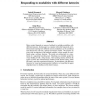Free Online Productivity Tools
i2Speak
i2Symbol
i2OCR
iTex2Img
iWeb2Print
iWeb2Shot
i2Type
iPdf2Split
iPdf2Merge
i2Bopomofo
i2Arabic
i2Style
i2Image
i2PDF
iLatex2Rtf
Sci2ools
NIPS
2004
2004
Responding to Modalities with Different Latencies
Motor control depends on sensory feedback in multiple modalities with different latencies. In this paper we consider within the framework of reinforcement learning how different sensory modalities can be combined and selected for real-time, optimal movement control. We propose an actor-critic architecture with multiple modules, whose output are combined using a softmax function. We tested our architecture in a simulation of a sequential reaching task. Reaching was initially guided by visual feedback with a long latency. Our learning scheme allowed the agent to utilize the somatosensory feedback with shorter latency when the hand is near the experienced trajectory. In simulations with different latencies for visual and somatosensory feedback, we found that the agent depended more on feedback with shorter latency.
Related Content
» FLIDDL
| Added | 31 Oct 2010 |
| Updated | 31 Oct 2010 |
| Type | Conference |
| Year | 2004 |
| Where | NIPS |
| Authors | Fredrik Bissmarck, Hiroyuki Nakahara, Kenji Doya, Okihide Hikosaka |
Comments (0)

